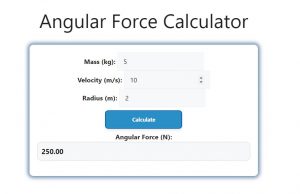About Angular Force Calculator (Formula)
The Angular Force Calculator is an essential tool for engineers and physicists dealing with rotational motion. Angular force, also known as centripetal force, is the force required to keep an object moving in a circular path. Understanding how to calculate angular force is crucial for designing rotating machinery, vehicles, and analyzing dynamic systems. This article explains the formula for calculating angular force, how to use the calculator, and provides a practical example to illustrate its application.
Formula
The formula for calculating angular force is:
F = (m * v²) / r
In this formula:
- F represents the angular force, measured in newtons (N).
- m is the mass of the object, measured in kilograms (kg).
- v is the linear velocity of the object, measured in meters per second (m/s).
- r is the radius of the circular path, measured in meters (m).
How to Use
Using the Angular Force Calculator involves the following steps:
- Determine the Mass (m): Measure or input the mass of the object in kilograms (kg).
- Measure Linear Velocity (v): Obtain the linear velocity of the object in meters per second (m/s).
- Input the Radius (r): Enter the radius of the circular path in meters (m).
- Input Values into the Calculator: Enter the values for mass, velocity, and radius into the Angular Force Calculator.
- Calculate Angular Force (F): Click the calculate button to obtain the angular force value.
- Analyze the Results: Review the calculated angular force to understand the dynamics of the system.
Example
Suppose you have an object with the following data:
- Mass (m): 5 kg
- Linear Velocity (v): 10 m/s
- Radius (r): 2 m
Using the formula:
F = (5 kg * (10 m/s)²) / 2 m
F = (5 kg * 100 m²/s²) / 2 m
F = 500 kg·m/s² / 2
F = 250 N
In this example, the angular force acting on the object is 250 newtons.

FAQs
- What is angular force?
Angular force, or centripetal force, is the force required to keep an object moving in a circular path. - How is angular force related to circular motion?
Angular force acts towards the center of the circular path, maintaining the object’s circular motion. - What units are used for measuring angular force?
Angular force is measured in newtons (N). - What is the significance of mass in this calculation?
The mass of the object directly affects the angular force required to maintain its circular motion. - How does linear velocity affect angular force?
Increasing linear velocity results in a quadratic increase in angular force, meaning small increases in speed significantly increase the force required. - What role does the radius play in this calculation?
The radius of the circular path inversely affects the angular force; a larger radius requires less force to maintain circular motion. - Can angular force be negative?
In physics, angular force is typically considered a positive value, as it represents a force acting towards the center of a circle. - What happens if the angular force exceeds the required force?
If the applied force exceeds the angular force required, the object will no longer follow a circular path and may move off tangentially. - Is this calculation applicable to all rotating systems?
Yes, the formula applies to any object moving in a circular path, including vehicles, satellites, and rotating machinery. - How can I determine the linear velocity of an object?
Linear velocity can be determined by the distance traveled along the circular path divided by the time taken. - What factors can influence the angular force?
Factors include mass, velocity, radius, and external forces acting on the object. - Are there practical applications for calculating angular force?
Yes, it is used in engineering, physics, automotive design, and many other fields to ensure stability and safety in rotating systems. - How can I ensure my calculations are accurate?
Use precise measurements for mass, velocity, and radius, and double-check your calculations for errors. - Can angular force change during motion?
Yes, if the mass, velocity, or radius changes, the angular force will also change. - What is the difference between angular force and torque?
Angular force is related to circular motion, while torque is the rotational equivalent of linear force, causing an object to rotate about an axis. - Can angular force be calculated for non-uniform circular motion?
Yes, but additional factors must be considered, such as variations in velocity and mass distribution. - How is angular momentum related to angular force?
Angular momentum depends on angular force and the duration of its application, affecting the motion of rotating bodies. - What is the role of friction in angular force calculations?
Friction can provide additional force that affects the angular motion, especially in systems with wheels or rotating elements. - Is there a maximum angular force an object can withstand?
Yes, each material has a limit to the forces it can endure before failure, which must be considered in design applications. - How can I visualize angular force?
Visualizing the force vectors acting on an object moving in a circle can help illustrate how angular force keeps the object in its path.
Conclusion
The Angular Force Calculator is a vital tool for anyone involved in physics or engineering, providing essential insights into the forces acting on objects in circular motion. By understanding how to calculate angular force, professionals can design safer and more efficient systems in various applications. Regular use of the calculator enhances understanding of the dynamics of rotational motion, leading to more informed engineering decisions and innovative solutions in technology.